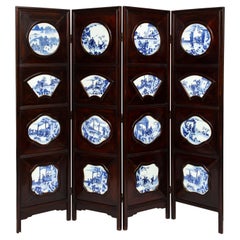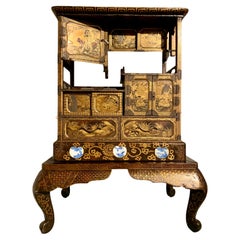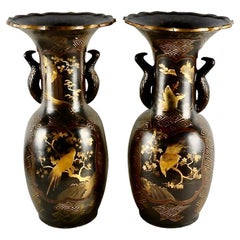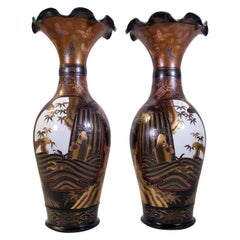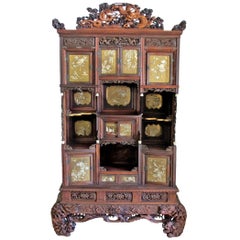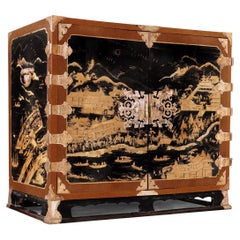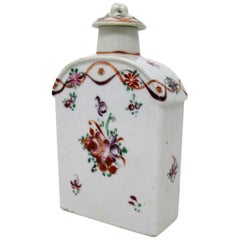Ceramic Lacquer
9
to
1
6
9
9
9
5
4
2
1
1
90,263
465
280
115
43
8
8
7
1
1
Material: Ceramic
Large Chinese 4-Fold Hardwood Screen inset with Blue & White Porcelain Plaques
Located in New York, NY
A large Chinese four-fold hardwood screen inset with blue and white porcelain plaques. The hand carved wood frame is a very dense and naturally rich and dark hardwood from China with...
Category
Early 1900s Chinese Qing Antique Ceramic Lacquer
Materials
Porcelain, Hardwood
Japanese Lacquer Display Cabinet on Stand, Meiji Period, 19th Century, Japan
Located in Austin, TX
A spectacular Japanese lacquer and porcelain inlaid display cabinet on stand, kazaridana, Meiji Period, late 19th century, Japan.
The sumptuous kazaridana of traditional display cabinet form, with several shelves and enclosed spaces for display and storage. The cabinet decorated all over in beautiful maki-e lacquer against a dense nashiji ground and inset with blue and white Arita porcelain plaques.
The front of the cabinet of asymmetric design, with two open display shelves at staggered heights, and several doors enclosing storage areas of various shapes and sizes, including one hinged corner door, two pairs of sliding doors, and one pair of hinged doors opening to reveal a rounded inset corner shelf. A pair of drawers below complete the cabinet. All supported on a separate tall fitted stand.
The corner door decorated with a bold scene of a samurai warrior fighting a demon. This most likely depicts the warrior Watanabe no Tsuna battling the demon Ibaraki-doji at Rashomon gate, in which Watanabe no Tsuna attempts to help a young girl return home, carrying her on his back, only for the girl to turn into a demon, which he then must fight.
The top pair of sliding doors with a scene of a man playing the sho, a Japanese mouth organ, along the banks of a river with a waterfall in the background.
The bottom pair of sliding doors with a waterfall scene on one side, while a scholar lounges with his attendants on the other.
The pair of hinged doors finely decorated with a pair of fully armored samurai.
The two drawers wonderfully decorated in the kodaiji style with a stream of rushing water and various plants and grasses.
The cabinet is decorated in the round, with the top, sides, and base of the cabinet decorated with various scenes of flowers and birds, and inset with blue and white Arita porcelain plaques in the form of traditional fan. The fans painted...
Category
1880s Japanese Meiji Antique Ceramic Lacquer
Materials
Porcelain, Softwood, Lacquer
Pair Japanese Lacquer-on-Porcelain Vases
Located in Pasadena, CA
This is a good example of Meiji period lacquer-on-porcelain large statement vases. The maki-e lacquer decoration features birds to one of the sides and ...
Category
Late 19th Century Japanese Meiji Antique Ceramic Lacquer
Materials
Porcelain, Lacquer
Early 20th Century Chinese Red Lacquer Plate
Located in CABA, AR
Introducing a stunning early 20th-century Chinese red lacquer plate, a testament to the exquisite artistry and craftsmanship of the period. This capt...
Category
Early 20th Century Ceramic Lacquer
Materials
Ceramic
Japanese Black Lacquer Box Together with a Blue and White Arita Plate
Located in Ottawa, Ontario
2 drawers. Drop down top. A Japanese black lacquer box
Together with a blue and white Arita plate,
20th century
Lacquer box of rectangular form with b...
Category
20th Century Japanese Japonisme Ceramic Lacquer
Materials
Ceramic, Lacquer
Pair of Antique 19th Century Japanese Porcelain Multicolored Lacquered Vases
Located in New York, NY
A monumental and unusual pair of antique 19th century Japanese porcelain poly-chrome lacquered vases. Each is beautifully designed with...
Category
1870s Japanese Chinese Export Antique Ceramic Lacquer
Materials
Porcelain
Japanese 7-Pcs, Arita Sweetmeat Set & Matching Lacquer Box Meiji Period, 1880s
Located in Ottawa, Ontario
A seven-piece Japanese Arita Sweetmeat set and matching lacquer box, Meiji period (1880-1890). Comprising of a central hexagonal dish and six-fan shaped ...
Category
Late 19th Century Japanese Meiji Antique Ceramic Lacquer
Materials
Porcelain, Lacquer
Tetsuya Yamada Untitled 'Red Seat'
By Shinman Yamada
Located in Sag Harbor, NY
Created by noted Japanese artist Tetsuya Yamada in 1998 this sculptural box/seat features fascinating combination of materials including antique wood, c...
Category
Late 20th Century Japanese Organic Modern Ceramic Lacquer
Materials
Ceramic
Japanese Edo Period Lacquer and Mother-of-Pearl Embellished Stoneware Koro
Located in Austin, TX
A highly unusual Japanese crackle glazed koro (incense burner or censer), lacquered and inlaid with mother-of-pearl embellishment, signed Gyokusen, Ed...
Category
19th Century Japanese Edo Antique Ceramic Lacquer
Materials
Copper
Related Items
Japanese Carved and Lacquered Shibayama Cabinet, Meiji Period
Located in San Francisco, CA
An elaborate and finely detailed carved wood, and gold lacquered Shibayama cabinet (Chigaidansu). Having beautifully applied semi-precious stone and ...
Category
19th Century Japanese Meiji Antique Ceramic Lacquer
Materials
Mother-of-Pearl, Wood
17th Century Japanese Export Lacquer Cabinet with Depiction the Dutch Tradepost
Located in Amsterdam, NL
A highly important Japanese export lacquer cabinet with depiction of the Dutch East India Company tradepost Deshima and the annual Dutch delegation on its way to the Shogun in Edo
Edo period, circa 1660-1680
H. 88 x W. 100.5 x D. 54 cm
This cabinet includes a later European japanned stand, but also a modern powder-coated steel frame.
The latter can be designed and added to your specific needs.
The sides and front of the rectangular two-door cabinet are embellished in gold and silver hiramaki-e and takamaki-e on a black roiro lacquer ground with a continuous design. The two doors depict a long procession of numerous figures travelling on foot and horseback along buildings and a pagoda into a mountainous landscape. This is the annual court journey, Hofreis, of the Dutch from Nagasaki to the Shogun’s court in Edo. Three horseback riders are dressed as Dutch merchants and a fourth figure, probably het Opperhoofd, is seen inside a palanquin, norimon. Just about to cross the bridge, two men are carrying a cabinet like the present one.
Many Japanese figures on either side of the procession are engaged in various activities; some play musical instruments on board of small boats, others are fishing; figures inside buildings are depicted playing go, and farmers are tending to their rice paddocks. The upper part of the right door shows a large mansion, probably the local daimyo’s castle, with men kneeling before a man in the central courtyard.
The court journey fits in with the foreign policy of the shogunate which accorded a role to the VOC alongside China, Korea, and the Ryukyu Islands who also had to pay tribute. However, the VOC employees were traders, having low status in Japan’s social hierarchy, and they were received with less deference than were the state embassies from Korea and the Ryukyu Islands. Nevertheless, the contacts with the Dutch were a welcome source of information to the Shogun about Europe and European science and technology.
The left side of the cabinet depicts, in mirror image, a rare view of the artificial fan-shaped Deshima Island, the trading post for the Dutch in Japan. The island, where the Dutch flag flies, is surrounded by small Japanese boats and an anchored three-masted fluyt (cargo ship), flying Dutch flags, with on the stern the VOC monogram. On the bottom right a busy street of Nagasaki is shown, bordered by shops and leading up to the stone bridge. On the island the trees are beautifully painted, two cows can be seen, and the flagpole, all in very fine detail. Dutchmen and enslaved Malay are visible outside the buildings and two Japanese figures, probably guards, sit in a small hut in the centre.
A maximum of fifteen to twenty Dutchmen lived on the island at any time and soldiers or women were not allowed. Restrictions on Deshima were tight, and the merchants were only allowed to leave the island by special permission. The Opperhoofd had to be replaced every year, and each new Opperhoofd had to make a court journey to pay tribute, present gifts, and to obtain permission to Margaret Barclay eep on trading. In the distance, many birds fly above the hills and a four-story pagoda can be seen. The right side of the cabinet is painted with other horse riders and their retinue journeying through mountains.
The pair of doors to the front open to reveal ten rectangular drawers. The drawers are decorated with scenes of birds in flight and landscapes with trees and plants. The reverse of the left door with two thatched buildings, one with a ladder, underneath a camelia tree with large blooms; the right door with a three-story pagoda nestled among trees and both doors with a flying phoenix, ho-oo bird. The cabinet, with elaborately engraved gilt copper mounts, hinges, lock plates and brass handles, is raised on an 18th-century English japanned wood stand.
A pair of large cabinets...
Category
17th Century Japanese Edo Antique Ceramic Lacquer
Materials
Copper, Gold
Free Shipping
H 34.65 in W 39.57 in D 21.26 in
Early 20th Century Burmese Lacquered Tray, “Pagan Bya”
Located in Atlanta, GA
Burmese (Myanmar) Lacquerware has a long tradition dating back to the 13th century. Lacquer in Burma is called “Thitsi” meaning the sap of a Thitsi Tree (Melanhorrea Usitata). Typica...
Category
Early 20th Century Burmese Ceramic Lacquer
Materials
Bamboo, Lacquer
Japan Red Lacquered Box 19th Century
Located in Beuzevillette, FR
Beautiful Japanese box in red lacquered wood. The lid is decorated with flowering magnolia branches and signed by the artist. The inside of the box is covered with a paint loaded wit...
Category
Late 19th Century Antique Ceramic Lacquer
Materials
Wood
Four Panel Chinese Coromandel Folding Lacquered Screen
Located in Highland, IN
This screen has four panels with brass feet. The front features a tranquil nature scene with a variety of birds bordered by a pattern flowering vine with four different antique vases...
Category
Mid-20th Century Chinese Chinese Export Ceramic Lacquer
Materials
Brass
Signed Japanese White Lacquer and Maki-E Lacquer Tansu, Meiji Period
Located in Ottawa, Ontario
The case decorated overall in crackle-glaze white lacquer and fitted with a patinated metal carrying handle over three tiers of small drawers. The first two tiers are comprised of a ...
Category
Late 19th Century Japanese Meiji Antique Ceramic Lacquer
Materials
Lacquer
Japanese Lacquer Box with Fine Maki-e Decoration Meiji Period
Located in Atlanta, GA
A lacquered wood box with lid from Japan circa 19th century Meiji Period. The finely decorated box was used to store paper slips and small documents on the desk. It is overall finished with black lacquer (kuro) with sparse Mura-Nashiji effect outside and on the top surface of the lid, there are three Komainu, (sometimes known as Shishi or Japanese lions) frolicking and forming a circle in lively motion. Komainu are auspicious animals in Japanese cultures in both Shinto and Buddhism tradition. Originally from China, these animals symbolizes guardians to ward off evil spirits. Hiramaki-e was used in combination with carving and combing to render the lions with various surface textures. A gilt border with an slight angle was given to the lid and even the thin band is decorated with miniature floral scrolls. The interior of the box was finished in a dense nashiji. Underneath the lid, a cluster of peonies open lavishly by two gentle mounts. Takamaki-e (high relief) in both gold and silver were...
Category
Late 19th Century Japanese Japonisme Antique Ceramic Lacquer
Materials
Wood, Lacquer
Broadway Folding Screen with Gold Leaf
Located in Paris, FR
Folding screen Broadway divided in six panels, two in golden leaf,
two black lacquered, another made through marquetry in walnut
wood and other in ebony veneer.
Category
21st Century and Contemporary Portuguese Ceramic Lacquer
Materials
Gold Leaf
Pair of Large Antique Japanese Hokai Lacquer Boxes
Located in Atlanta, GA
A pair of Japanese lacquered lidded Hokai boxes with chased brass hardware and original ropes. Hokai boxes are traditionally used in Japan as the containers ...
Category
Early 20th Century Japanese Japonisme Ceramic Lacquer
Materials
Wood, Lacquer
Antique 19th Century Japanese Imari Porcelain Vase
Located in Pearland, TX
19th-Century Japanese Imari porcelain vase. This fine vase have a lovely shape and hand painted floral designs in the traditional Imari colors.
Category
19th Century Japanese Japonisme Antique Ceramic Lacquer
Materials
Porcelain
Pair of Antique Japanese Lacquer Trays
Located in Hudson, NY
Pair of antique Japanese Lacquer Trays, Taisho period (1912-1926) beautifully decorated with a miniature landscape of pea pods on the vine and a gold cricket set...
Category
1920s Japanese Taisho Vintage Ceramic Lacquer
Materials
Lacquer
Japanese Maki-e Lacquer Stack Box Jubako
Located in Atlanta, GA
An antique jubako (stack boxes) with five tiers in an elongated octagon shape circa 19th century (end of Edo or beginning of Meiji period). jubako was traditionally used to store and...
Category
19th Century Japanese Japonisme Antique Ceramic Lacquer
Materials
Wood, Lacquer
Previously Available Items
Chinese Canton Porcelain Famille Rose Dome Top Enameled Tea Caddy Qianlong 18 Ct
Located in Dublin, Ireland
Stunning rare Famille Rose “European-subject” Chinese porcelain tea caddy of fine quality,
circa 1780.
Exquisitely enameled to the ...
Category
18th Century Chinese Chinese Export Antique Ceramic Lacquer
Materials
Porcelain
H 5.25 in W 3 in D 1.5 in
Kutani Japanese Divided Dish Serving Set on a Lazy Susan Rotating Base
Located in Ottawa, Ontario
Kutani Japanese divided seven piece dish serving set on a lazy Susan rotating base, circa 1950s-1960s, on a black lacquered rotating bowl on a raised sta...
Category
1950s Japanese Japonisme Vintage Ceramic Lacquer
Materials
Porcelain
20th Century Pair of Chinese Cinnabar and Enamel Lidded Urns on Stand
Located in Dallas, TX
Gorgeous pair of early 20th century Chinese cinnabar lacquer and enameled lidded urns or vases on wooden stands.
Each urn consists of an enameled base (Cloisonné), blue enamel on ...
Category
Early 20th Century Chinese Chinese Export Ceramic Lacquer
Materials
Bronze
Japanese Fine Antique Hand Lacquered Complete Bento Food Box, Early 20th Century
Located in South Burlington, VT
Mint and boxed
Japan, a fine antique hand lacquered Maki-e seasonal flowers and fans decorated portable complete Bento food box, late Meiji to early Taisho period, early 20th century.
The set comes with a four (4) lacquered and porcelain elements: the Obento box consisting of four (4) boxes with lids, a small serving tray for Sakazuki Sake sipping, a white porcelain Sakazuki with cloth bag, The entire set fits in to a very elegant portable protective storage box, crafted of Kiri wood..
Decorations: The set is decorated with season spring flowers motif and Maki-e lacquer art.
Condition: Excellent with fine patina. Immediately usable.
Dimensions: Obento 7 inches high and the portable box...
Category
Early 20th Century Japanese Meiji Ceramic Lacquer
Materials
Porcelain, Silk, Wood, Lacquer
H 10 in W 6 in D 6 in
Japanese Red Lacquer Cabinet and Stand Satsuma Panels, 19th Century
Located in Bishop's Stortford, Hertfordshire
An exceptional antique Japanese red cinnabar lacquer table cabinet on stand inset with finely painted Satsuma panels, possibly Kinkozan, with en...
Category
19th Century Japanese Antique Ceramic Lacquer
Materials
Porcelain, Lacquer
Free Shipping
H 19.3 in W 13.59 in D 8.08 in
Faux Bamboo Baby Changing Table Lilly Pulitzer Elephant Pink Lacquered Girl
By Thomasville
Located in West Palm Beach, FL
The most amazing custom, changing table! Newly lacquered in a white gloss finish, drawer with dividers, ceramic elephant drawer knobs, all new changing table pad with Lilly Pulitzer ...
Category
1970s American Hollywood Regency Vintage Ceramic Lacquer
Materials
Ceramic, Faux Bamboo, Wood, Lacquer
Miniature Porcelain Vases
Located in New York, NY
Miniature porcelain vases with beautiful Chinese imagery. In main image, piece on the left and in the middle are available. Priced individually. From Shanxi Province, c. 1900.
CR666
Category
Early 20th Century Chinese Ceramic Lacquer
Materials
Porcelain
Recently Viewed
View AllMore Ways To Browse
Maki E
Antique Japanese Lacquer Tray
Japanese Lacquer Tray Antique
Antique Chinese Cinnabar
Black Lacquer Asian Floral
Vintage Japanese Lacquer
Red Lacquer Cinnabar
Lacquer Ware
Asian Small Lacquer Box
Japanese Family Crest
Japanese Black Lacquer Tray
Black Cinnabar
Kyoto Lacquer
Japanese Mother Of Pearl Art
Chinese Carved Cinnabar
Burmese Red Lacquered
Japanese Pearl Inlay
Large Japanese Tray
